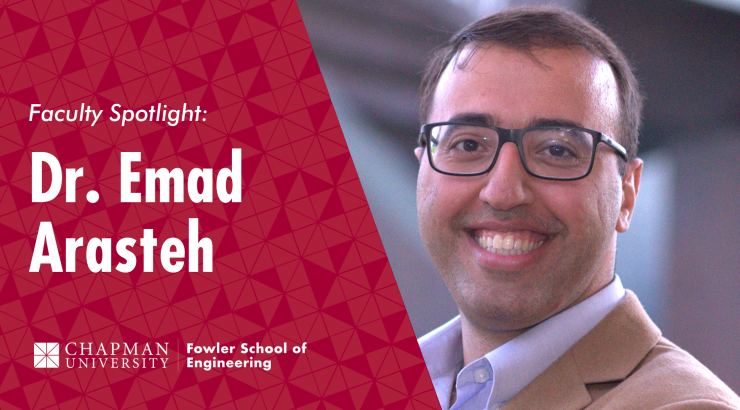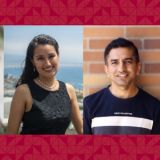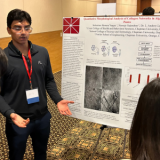
Bridging Disciplines to Build Solutions: Engineering Professor Inspires Interconnectivity in and Out of the Classroom Faculty Spotlight: Dr. Emad Arasteh
June 30, 2023
Faculty Name: Dr. Emad Arasteh
Course(s) Taught: ENGR 101: Foundations of Design and Fabrication, CENG 231: Systems Programming, CENG 231L: Systems Programming Laboratory, CENG 381: Modeling and Simulation
Within the realm of engineering, bridging gaps between experiences and research communities is a vital ingredient for success—an idea that especially rings true for Dr. Emad Arasteh, an Assistant Professor who joined the Fowler School of Engineering (FSE) faculty last year. His conscious effort to prioritize interconnectivity across disciplines, schools, and those with both typical and unconventional research paths is key to his goal of solving technological challenges relevant to daily life.

While presenting his research at the 2019 International Embedded Systems Symposium in Friedrichshafen, Germany was exciting in and of itself, one of Arasteh’s greatest takeaways was the experience of meeting other researchers and scholars in his field.
Arasteh’s time in both industry and academic settings is a testament to his eagerness when embracing unique and multifaceted experiences. Prior to teaching, his decade of experience as a hardware and software engineer at companies such as Samsung and Intel has taken his electronic design work all across Sweden and the United States. He has also presented his research at a variety of prestigious conferences and symposiums worldwide. In the fall, Arasteh is offering a new course in Modeling and Simulation (CENG 381), which will allow him to draw upon both his professional experiences and research expertise to provide meaningful and relevant instruction.
We reached out to Arasteh to discuss his journey from industry to academia, gaining insight into the web of different experiences that brought him onto Chapman’s campus.
Q&A With Dr. Emad Arasteh
Q: How might you describe your work to those who may not be familiar with the field, technology, and/or research process?
Arasteh: The main theme of my research is the design and modeling of embedded computer systems. Embedded computers are those that do not look like normal computers—though they do not have normal keyboards/mouses or monitors, they have all components of a modern computer such as processors, input/output devices (touch screen, voice command), and connectivity (5G, WiFi, Bluetooth).

In July 2022, Arasteh presented his work entitled “Explore Parallelism and Memory Contention in System Level Models by Assessing PDES Performance” at the Design Automation Conference (DAC)’s PhD Forum in San Francisco, CA. While there, he met up with a past colleague, Gabriel Jönsson (pictured above).
Embedded computers have become ubiquitous in our everyday lives and their applications cover a wide range of areas, such as consumer electronics, telecommunication, robotics, health, factory automation, and transportation. While the pervasiveness of embedded or cyber-physical systems has increased significantly over a few decades, the next wave will be to design intelligent systems that are efficient, safe, reliable, and can learn from and adapt to their environments.
Q: What core values or relevant worldly applications do you think drive your research—what lies at the heart of your work?
Arasteh: I find connecting separate scientific domains both challenging and exciting. In my research, I strive to bridge the hardware and software domains. New software applications are consistently emerging by innovations in artificial intelligence (AI) and machine learning (ML). On the other hand, we are facing the outset of significant advances in semiconductor and hardware technology. Bridging advances in these two dynamic, fast-paced domains is truly challenging, but there is an engineering saying that “the harder, the better.”
Q: What has been your biggest challenge so far, either one you’re still working on or something you feel proud of overcoming? Similarly, what have been your greatest successes?
Arasteh: [Concerning challenges] I have had quite an unconventional path to academia; I spent years in the tech industry in different roles and companies. I moved from Europe (Sweden) to the U.S. to pursue my Ph.D. degree with few expectations, and I’m humbled that Chapman University has found my background interesting.
On the research side, I have recently learned the good news that my Ph.D. work was accepted to the ACM Transactions on Embedded Computing Systems (TECS) for publication, which is one of the most prestigious journals in my field. I’m also excited about setting up a new research lab focused on computer systems design at the Fowler School of Engineering.
Q: How have you brought your industry knowledge and research into the classroom thus far?

For Arasteh, a great deal of learning occurs through informal conversations with mentors in both the industry and academia. Here, Arasteh sits with his “academic family”: (from left) his Ph.D. advisor’s own advisor, Professor Daniel Gajski (UC Irvine); his academic advisor, Professor Rainer Doemer (UC Irvine); and his “academic uncles,” Professor Nikil Dutt (UC Irvine) and Professor Achim Rettberg (Hamm-Lippstadt University, Germany).
Arasteh: Spending over a decade in the industry has given me good familiarity and exposure to a wide range of first-hand use cases and technology products. When I teach a course, I focus on demonstrating real-life examples to reinforce the underlying theories. I also strive to highlight how different topics in the course are related to each other to be able to draw the big picture. In my research, I usually look for questions that solve a problem in the industry.
Q: What impresses you most about the experience of conducting research and teaching at Chapman?
Arasteh: I have been with FSE for almost a year now and greatly enjoy our small class sizes and cozy campus. Having close interaction with students, staff, and faculty is a blessing.
Although it has been a short time since I started at Chapman, I have already noticed great enthusiasm in our students to explore new venues right from the very beginning of their studies. It is also amazing to see a great culture of creativity, building, and crafting at Fowler. I have found this positive vibe crucial for conducting research.
Q: What advice might you have for students also interested in similar research paths?

Dr. Arasteh among several other influential members of Fowler faculty: Dr. Alexander Kurz, Dr. Michael Fahy, and Dr. Tom Springer.
Arasteh: I’d like to highlight to our students to be open, try new things, and even occasionally make themselves uncomfortable. Sometimes the benefits may not be clear in the beginning; hopefully those new challenges and experiences will pay off in the long run.
For more information about Dr. Arasteh and his research, please visit his official office page.

